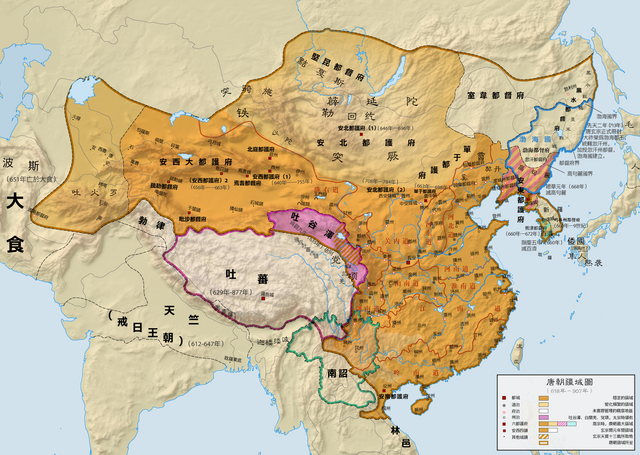Loading AI tools
Early medieval region in southern Central Asia From Wikipedia, the free encyclopedia
Tokharistan (formed from "Tokhara" and the suffix -stan meaning "place of" in Persian) is an ancient Early Middle Ages name given to the area which was known as Bactria in Ancient Greek sources.
Tokharistan | |
|---|---|
| Capital | Balkh |
| Historical era | Early Middle Ages |
| Today part of | Afghanistan, Uzbekistan, Tajikistan |

By the 6th century CE Tokharistan came under rule of the First Turkic Khaganate, and in the 7th and 8th centuries it was incorporated into the Tang dynasty, administered by the Protectorate General to Pacify the West.[4] Today, Tokharistan is fragmented between Afghanistan, Uzbekistan and Tajikistan.
Several languages have used variations of the word "Tokhara" to designate the region:
Several portraits of ambassadors from the region of Tokharistan are known from the Portraits of Periodical Offering of Liang, originally painted in 526–539 CE. They were at that time under the overlordship of the Hephthalites, who led the embassies to the Southern Liang court in the early 6th century CE.
The name of "Tocharians" was mistakenly applied by early 20th century authors to the Indo-European people of the Tarim Basin, from the areas of Kucha and Agni. These scholars erroneously believed that these Indo-Europeans had originated in Tokharistan (Bactria), and hence applied the term "Tocharians" to them. This appellation remains in common usage although the Indo-European people of the Tarim Basin probably referred to themselves as Agni, Kuči and Krorän.[17][18]
In the Xi'an Stele, erected in 781 CE, the Church of the East monk Adam, author of the stele, mentioned in Syriac that his grandfather was a missionary-priest from Balkh (Classical Syriac: ܒܠܚ, romanized: Balḥ) in Tokharistan (ܬܚܘܪܝܣܬܢ Taḥuristan).[19][20][21]

Geographically, Tokharistan corresponds to the upper Oxus valley, between the mountain ranges of the Hindu-Kush to the south and the Pamir-Alay to the north.[4] The area reaches west as far as the Badakshan mountains, south as far as Bamiyan.[4] Arab sources considered Kabul as part of the southern border of Tokharistan, and Shaganiyan as part of its northern border.[4] In a narrow sense, Tokharistan may only refer to the region south of the Oxus.[4] The region used the East Iranian Bactrian language, which was current from the 2nd to the 9th century CE.[4]
The most important city of Tokharistan was Balkh, which was at the center of the trade between Iran (the Sasanian Empire) and India.[4]
The region of Tokharistan had been outside of Sasanian control for the three centuries preceding the Muslim conquest of Persia in 633–651 CE.[4] During that time, Tokharistan was under the rule of dynasties of Hunnish or Turkic origin, such as the Kidarites, the Alchon Huns and the Hephthalites.[4] At the time of the Arab conquest, Tokharistan was under the control of the Western Turks, through the Tokhara Yabghus.[4]
Numerous artefacts exist from the art of early medieval Tokharistan, which shows influence from the Buddhist art of Gandhara.[22]
Many authors have suggested that the figures in the Dilberjin Tepe or Balalyk Tepe paintings are characteristic of the Hephthalites (450–570 CE).[23] In this context, parallels have been drawn with the figures from Kizil Caves in Chinese Turkestan, which seem to wear broadly similar clothing. The paintings of Balalyk Tepe would be characteristic of the court life of the Hephthalites in the first half of the 6th century CE, before the arrival of the Turks.[24][25]
In painting, there is "Tokharistan school of art"[citation needed] (see Northern Buddhist art) with examples from Kalai Kafirnigan, Kafyr Kala or Ajina Tepe,[28][29] as Buddhism and Buddhist art enjoyed a renaissance, possibly owing to the sponsorships and religious tolerance of the Western Turks (Tokhara Yabghus).[30]
Islamic art developed with the Samanid Empire and the Ghaznavids from the 10th to 12th century CE.
Seamless Wikipedia browsing. On steroids.
Every time you click a link to Wikipedia, Wiktionary or Wikiquote in your browser's search results, it will show the modern Wikiwand interface.
Wikiwand extension is a five stars, simple, with minimum permission required to keep your browsing private, safe and transparent.